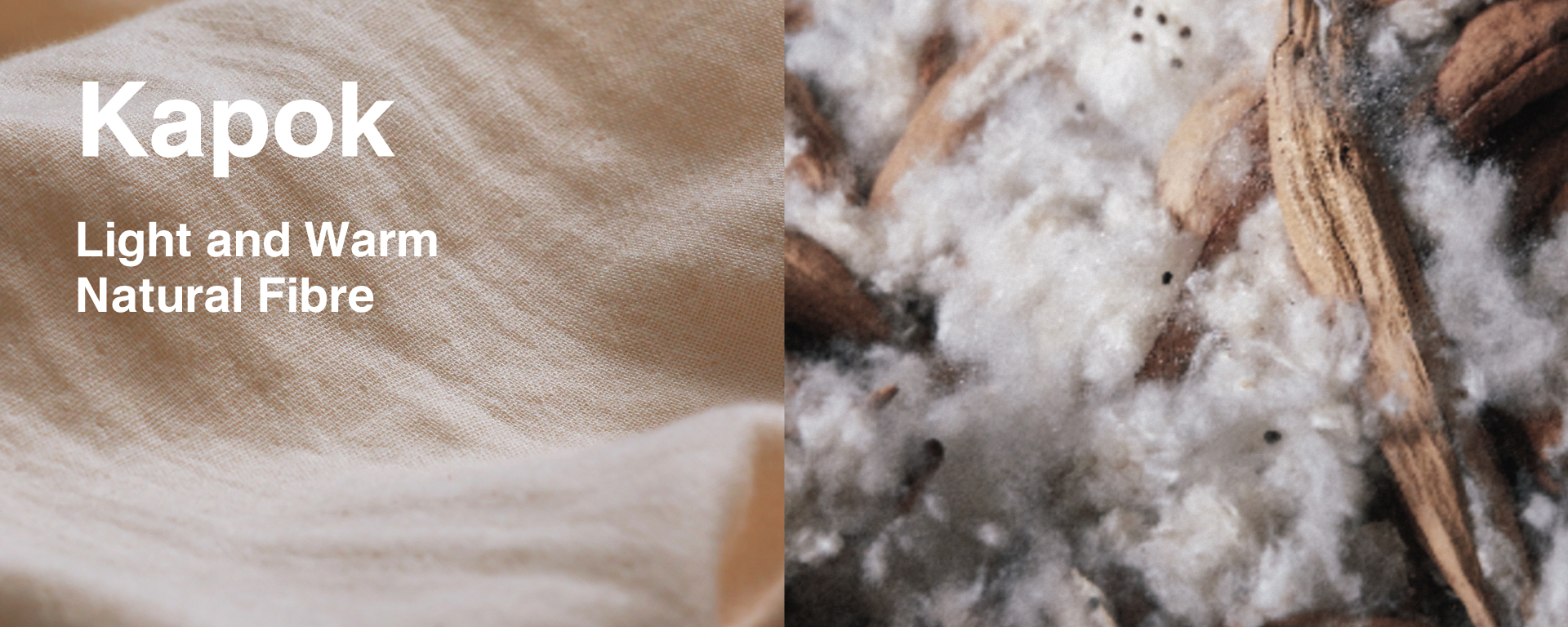
At the time when there were no synthetic fiber materials such as petroleum-derived polyester,Kapok, a natural material, was used as such. At this age where people are looking to reduce environmental impact to the earth, MUJI is once again paying attention to kapok.With functions created from nature, it keeps you comfortable at all times.
-
Light
The lightest natural fiber in the world
Kapok fiber weighs about one-eighth of cotton. As the inside of the fibre is hollow like straws, it becomes a soft and supple fabric that is fluffy and light.
-
Always comfortable
Natural functional material
The straw-shaped cavity traps a lot of air, in cold weather, the fabric absorbs moisture and enhances the heat retention effect. Whereas in hot weather, it wicks away moisture to maintain a comfortable temperature.
-
Friendly to the nature
Reduce environmental impact
Kapok trees need minimal pesticides, fertilizers, or watering. Harvesting the fiber from the fruit doesn't involve tree cutting. With its low environmental impact and continued carbon dioxide absorption, kapok is an eco-friendly material.
Since the trunk is not cut down when the fruits are harvested, it is attracting attention as a material with a very low environmental impact.
Ladies'
Men's
Kids / Accessories / Homewear
Only available at MUJI Plaza Singapura or Online Store
-
Kapok Forest & Reducing Environmental Impact
Kapok is a deciduous tree that is widely cultivated in Indonesia, Thailand and India.
It requires almost no pesticides, fertilizers, or watering, and grows under sunlight and rainwater, which is the blessing of nature.
In the forests of Java, Indonesia, where the kapok used by MUJI is produced, trees are systematically planted at intervals of about 5 meters and cultivated in a state close to nature.Kapok Forest & Reducing Environmental Impact
Kapok is a deciduous tree that is widely cultivated in Indonesia, Thailand and India.
It requires almost no pesticides, fertilizers, or watering, and grows under sunlight and rainwater, which is the blessing of nature.
In the forests of Java, Indonesia, where the kapok used by MUJI is produced, trees are systematically planted at intervals of about 5 meters and cultivated in a state close to nature.
-
Unlike other fibers such as cotton and linen, kapok tree does not get damaged during kapok fibre harvesting.
As it grows taller and taller, it absorbs carbon dioxide and converts them into oxygen.
It has a green trunk and hence not only the leaves but also the entire tree performs photosynthesis, so the entire forest absorbs a large amount of carbon dioxide and reduces the cause of global warming.
-
From Harvesting to becoming Fiber
Kapok blooms with white flowers around May, begins to bear fruit around June, and is harvested from September to November.
From one tree, 300 to 400 kapok fruits weighing about 22 to 30 kg can be harvested, which yields about 8kg of cotton.
Cotton pops out of unharvested fruit when it bursts open and returns to the soil.From Harvesting to becoming Fiber
Kapok blooms with white flowers around May, begins to bear fruit around June, and is harvested from September to November.
From one tree, 300 to 400 kapok fruits weighing about 22 to 30 kg can be harvested, which yields about 8kg of cotton.
Cotton pops out of unharvested fruit when it bursts open and returns to the soil.
-
After harvesting the kapok fruit, remove the cotton. The husks are cracked to retrieve cotton which is then dried in the sun. After that, impurities are removed, and it is spun and commercialized.

-
Use of Kapok
The fibers of kapok are short and were considered unsuitable for use as thread. For this reason, in the days before petroleum-derived synthetic fibers such as polyester existed, it was used as stuffing for pillows and stuffed toys, and as the filling material for life jackets.
In recent years, the development of new technology has enabled spinning, and the production of silk, weaving, and clothing is progressing. It is a sustainable material that is attracting attention.Use of Kapok
The fibers of kapok are short and were considered unsuitable for use as thread. For this reason, in the days before petroleum-derived synthetic fibers such as polyester existed, it was used as stuffing for pillows and stuffed toys, and as the filling material for life jackets.
In recent years, the development of new technology has enabled spinning, and the production of silk, weaving, and clothing is progressing. It is a sustainable material that is attracting attention.